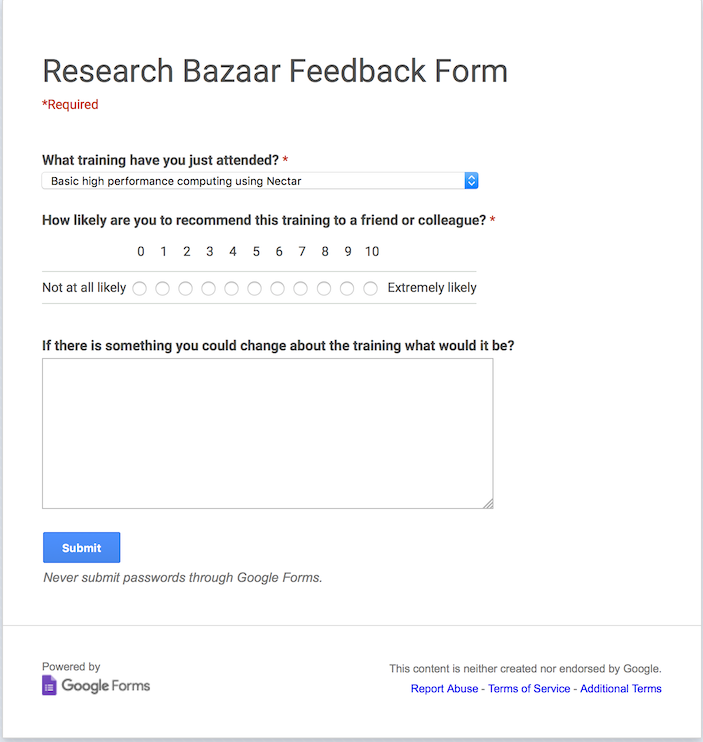Feedback
Now that we've all had turns presenting and getting feedback, let's turn our attention to our getting feedback for the course on the day.
Sticky notes
We have found the Software Carpentry technique of using sticky notes to be very handy.
Observation But you need to drive the use of the sticky notes. If you don't take control, people just leave them up (or down) and it can get very confusing.
Multi choice questions
The multi-choice questions also give a really good idea as to who needs more explanation. They also allow us to break up the proceedings with some humour.
The multi choice question answer cards are a real pain to manage and distribute. Having each answer a different colour works really well in allowing us to see who has answered what without having to read the cards.
Minute cards
We use minute cards: at the end of a session, learners write one thing
- that they've learnt on their green sticky note
- that they found confusing or think could be improved on their red sticky note
Observation To repeat, we've found that the use of minute cards is brilliant. Especially the negative comments. But to be effective you have to sort them and work through them as soon as is possible after the training.
-- Slide --
Sample feedback from a course
Voyeurs!
-- Slide End --
Instructor feedback
Instructor feedback is also something we practice.
Although I suspect that this might be largely self affirming. In which case do we get value from it?
Post workshop assessment
The post workshop assessment is another practice that the University follows.
To do this we use the Net Promoter Score metric.
We send out an email customized to the session, along the lines of:
-- Slide --
Thank you so much for attending the basic high performance computing with NeCTAR course yesterday.
If you haven’t done so already, please take two minutes to fill out this anonymous two-question survey on how you felt the training went:
https://docs.google.com/forms/d/18-FVw2R3svRyh6AE4ropHcors0wc50tqoBX5R5dUOOoo/viewform
For those of you who asked for more links to material on the cloud side:
We covered the basic concepts:
- http://training.nectar.org.au/package01/sections/all.html
- http://training.nectar.org.au/package05/sections/all.html
...
-- Slide End --
When the learners click on the link they see the following Google form:
-- Slide --
Feedback form

-- Slide End --
The form asks for one question on a numeric scale to be answered. Those who answer
- 9 - 10 are seen as promoters
- 7 -8 are seen as passive
- Everything below this is seen as being detractors.
-- Slide --
Net Promoter Score
For more on this:
-- Slide End --
In line with Software Carpentry we get very poor returns: at the moment we are at about 30%. But on the upside we've had no response below 7, and the comments have all been most useful.
Summary feedback
-- Slide --
Summary feedback
We haven't trialed summary feedback yet :(
-- Slide End --
Observation We find most people are scrambling to leave - you are all frazzled, and it requires a special kind of control to stop everyone and to get them to talk about the day.
Etherpads
-- Slide --
An Etherpad from one of our courses...
-- Slide End --
Observation We find that our learners don't typically engage with the Etherpads. But they do like having the links readily available.
Instructor evaluations
Of interest is that instructor evaluations are not worthwhile) This mirrors my personal observation: that the learners rate their instructors by impression rather than by ability.
-- Slide --
True or False: We only use 10% of our brain...
- G = True.
- R = False.
-- Slide End --
A False: If true, we should be able to survive the loss of 90% of our brain quite happily...
Also, modern scanning techniques have shown that this is false. Simple activities, such as walking into a room full of people, or playing a musical instrument, cause all of your brain to light up!